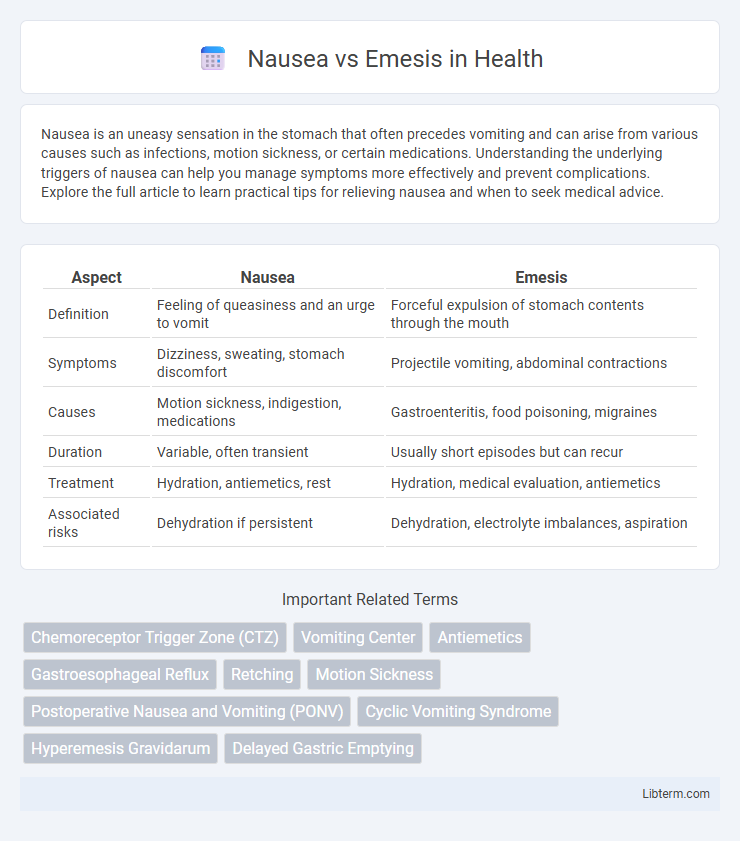Nausea is an uneasy sensation in the stomach that often precedes vomiting and can arise from various causes such as infections, motion sickness, or certain medications. Understanding the underlying triggers of nausea can help you manage symptoms more effectively and prevent complications. Explore the full article to learn practical tips for relieving nausea and when to seek medical advice.
Table of Comparison
| Aspect | Nausea | Emesis |
|---|---|---|
| Definition | Feeling of queasiness and an urge to vomit | Forceful expulsion of stomach contents through the mouth |
| Symptoms | Dizziness, sweating, stomach discomfort | Projectile vomiting, abdominal contractions |
| Causes | Motion sickness, indigestion, medications | Gastroenteritis, food poisoning, migraines |
| Duration | Variable, often transient | Usually short episodes but can recur |
| Treatment | Hydration, antiemetics, rest | Hydration, medical evaluation, antiemetics |
| Associated risks | Dehydration if persistent | Dehydration, electrolyte imbalances, aspiration |
Introduction: Understanding Nausea and Emesis
Nausea is the unpleasant sensation of an impending need to vomit, often triggered by gastrointestinal disturbances, motion sickness, or metabolic imbalances. Emesis, commonly known as vomiting, is the forceful expulsion of stomach contents through the mouth, serving as a protective reflex to eliminate toxins or irritants. Understanding the physiological and neurological pathways underlying nausea and emesis is critical for effective diagnosis and treatment of these interconnected symptoms.
Definition of Nausea
Nausea is the unpleasant sensation of a need to vomit, often preceding or occurring without emesis, which is the actual expulsion of stomach contents through the mouth. It is a subjective feeling characterized by discomfort in the upper abdomen and throat, frequently linked with dizziness and sweating. Nausea serves as a protective mechanism signaling underlying issues such as gastrointestinal disturbances, motion sickness, or medication side effects.
Definition of Emesis
Emesis, commonly known as vomiting, is the forceful expulsion of stomach contents through the mouth, triggered by the complex coordination of gastrointestinal and neurological pathways. It serves as a protective reflex to remove harmful substances and can be caused by various factors including infections, toxins, or motion sickness. Unlike nausea, which is the unpleasant sensation that often precedes vomiting, emesis is the physical act that expels gastric contents and resolves the discomfort.
Key Differences Between Nausea and Emesis
Nausea is the subjective sensation of discomfort or unease in the stomach often preceding the urge to vomit, while emesis refers to the physical act of vomiting and expelling stomach contents through the mouth. Nausea serves as a warning signal indicating potential gastrointestinal distress, whereas emesis is the body's protective reflex mechanism to remove harmful substances. Clinically, nausea is treated with antiemetic medications to prevent progression to emesis, which may require more aggressive interventions if persistent or severe.
Common Causes of Nausea
Nausea is commonly caused by gastrointestinal disorders such as gastritis, gastroenteritis, and peptic ulcers, as well as systemic conditions like migraines, pregnancy, and motion sickness. Emesis, or vomiting, often follows severe nausea and can be triggered by these same causes along with infections, toxins, and certain medications. Understanding these underlying factors is crucial for effective treatment and management of symptoms.
Common Causes of Emesis
Emesis, commonly known as vomiting, is frequently caused by gastrointestinal infections, motion sickness, pregnancy (morning sickness), and food poisoning. Central nervous system disorders such as migraines, increased intracranial pressure, and vestibular dysfunction can also trigger emesis. Common medications, chemotherapy, and certain toxins are additional significant causes contributing to emesis episodes.
Symptoms Accompanying Nausea and Emesis
Nausea often presents with symptoms such as dizziness, sweating, and an increased salivation, signaling an unpleasant sensation that precedes vomiting. Emesis, or vomiting, is typically accompanied by abdominal cramps, retching, and a rapid increase in heart rate as the body forcibly expels stomach contents. Understanding the distinction between these symptoms aids in diagnosing underlying conditions like gastroenteritis, motion sickness, or more severe gastrointestinal disorders.
Diagnostic Approaches
Diagnostic approaches for nausea versus emesis involve distinct but complementary methods to identify underlying causes. Nausea is often assessed through patient history, symptom characterization, and laboratory tests such as serum electrolytes and metabolic panels to detect systemic causes. Emesis diagnosis includes physical examination, imaging techniques like abdominal ultrasound or CT scans, and endoscopy to evaluate gastrointestinal tract abnormalities and obstructive conditions.
Treatment Options for Nausea and Emesis
Treatment options for nausea include antiemetic medications such as ondansetron, promethazine, and metoclopramide, which target different receptors to reduce symptoms. Emesis management often involves similar antiemetics alongside hydration therapy and electrolyte replacement to address fluid loss and prevent complications. Non-pharmacological approaches like dietary modifications, acupressure, and behavioral therapy can complement medical treatments for both nausea and emesis, improving patient outcomes.
Prevention Strategies and Lifestyle Tips
Preventing nausea involves hydration, avoiding strong odors, eating small, frequent meals, and managing stress through relaxation techniques. Emesis prevention focuses on identifying triggers such as motion sickness or certain medications and using antiemetic drugs as prescribed by healthcare providers. Incorporating balanced diets rich in ginger or peppermint and maintaining upright posture after meals can minimize both nausea and vomiting episodes.
Nausea Infographic

 libterm.com
libterm.com